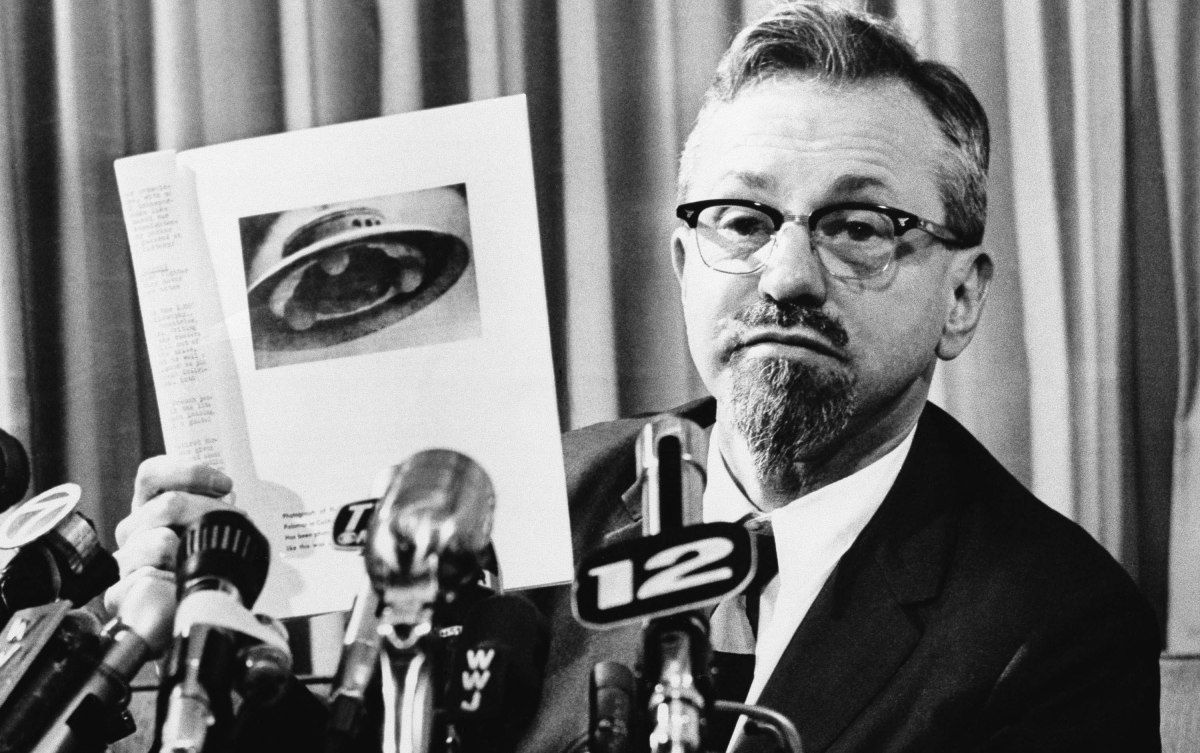An Unmet Threat
Article by Christopher Mellon February 18, 2020 (legion.org)
• This article is a plea to the US government written by Christopher Mellon (pictured above), a former deputy assistant secretary of defense for intelligence in the Bill Clinton and George W. Bush administrations. Today, Mellon is an adviser to Tom DeLonge’s ‘To the Stars Academy for Arts and Science’ and he serves as a contributor to HISTORY’s television series: “Unidentified: Inside America’s UFO Investigation.”
• Ever since the days of Project Sign in 1948 and Project Bluebook which ended in 1969, the US Government’s reports on UFOs were designed to debunk UFO sightings and discredit civilian UFO researchers. The government’s only objective was to reassure the public that no case “reported, investigated and evaluated by the Air Force has ever given any indication of threat to our national security,” and that there is “no evidence of developments or principles beyond the range of modern scientific knowledge.” The stigma the Air Force sought to create worked only too well, causing most US military and intelligence personnel to conceal rather than report UFOs – a self-blinding process that resulted in decades of lost data.
• But on December 16, 2017, The New York Times ran a front-page story revealing the existence of a Congressionally mandated Pentagon program to study UFOs. The article was accompanied by two declassified DoD videos obtained by Navy F-18 fighter pilots. The UFOs were seen in broad daylight by numerous Navy personnel and demonstrated revolutionary aeronautical capabilities. These reports were independently corroborated by sophisticated military sensor systems. And a Navy spokesman admitted that the Navy videos were neither a hoax nor secret US test aircraft. They were “UAPs” – ‘unidentified aerial phenomena’. With this short statement, the Navy upended the conclusions of every prior US government examination of the UFO phenomenon.
• There is nothing more compelling than hearing the Navy pilots’ stories firsthand. Navy pilot Commander David Fravor who encountered the ‘tic tac’ UFO off of California in 2004 and Lieutenant Ryan Graves, a Navy pilot who said that the UFOs followed his Navy strike group for months, have expressed how anxious they are to find out what technology these strange craft are using to defy the laws of physics, tumbling through nonsensical angles to maintain a dominant position. In the “Gimbal” video (off of the coast of Florida in 2015) posted by The New York Times, one of the pilots is heard to exclaim, “There’s a whole fleet of them out there!” He was referring to a V-shaped formation of smaller craft approaching the fighters as they observed a larger “mothership” in the video. At close range, these bizarre craft appear to be black cubes, the corners of which are touching the inside of transparent spheres a mere six feet in diameter. There are no discernible air inlets, exhaust, wings, or means of lift or propulsion, yet they have been tracked at supersonic speeds and seem able to remain aloft indefinitely. Fravor’s anonymous female ‘wingman’ pilot noted, “We didn’t stand a chance against it.” Navy F-18 pilots would not say that about any Russian or Chinese fighter.
• This should be taken to heart by DoD officials and Congress. Commander Fravor and his colleagues expect their nation to find out where these things come from, why they are here, and how they work. A handful of senators and representatives on national security oversight committees have sought briefings. Yet an obdurate DoD bureaucracy seems to be making almost no effort to determine the origin of these craft or their means of propulsion.
• If we knew for certain that the Russian or Chinese militaries had leapfrogged the United States technologically, there would be a public uproar for increased investigation and action. Such initiatives were spurred on by the Soviet’s Sputnik satellite in the 1950s and paid handsome dividends with thousands of new patents and the US taking the lead in science and technology. The only response we’ve seen to these UAPs has been the Navy updating and formalizing its reporting process. No major investigations have been launched. There is no indication that DoD or the intelligence community leadership is engaged at all.
• There is still no process for collecting and integrating pertinent UFO/UAP information among the myriad US agencies and departments. At the same time, the House Committee on Space, Science and Technology directed NASA to begin looking for “technosignatures,” i.e.: alien space probes. There is no denying the possibility that some UAPs encountered by our military are probes launched by distant civilizations. Inability to identify the radical UAPs violating our airspace is an ongoing intelligence failure, one that arguably requires written notification to the House and Senate intelligence committees pursuant to Section 502 of the National Security Act of 1947.
• Indeed, there are things we could be doing. Analysts could review archived data of the ‘tic tac’ UFO incident in November 2004 from the Nimitz carrier strike group’s infrared radar system, or the International Monitoring System, or various space-based electronic sensors. Reviews of this kind for incidents occurring off the East Coast since 2015 should also be conducted. Direction from Congress or a senior administration official is all it would take to initiate the process. With little effort or expense, the Trump administration could request a National Intelligence Estimate on “anomalous aerospace threats”. Or Congress could fund an independent civilian panel under the auspices of the National Science Foundation.
• Our government’s failure to thoroughly investigate these UFO anomalies is due to our policymakers prioritizing political expediency over national security. This is a state of affairs reminiscent of the declining Roman Empire when the needs and concerns of troops in the field were largely ignored by self-serving politicians in Rome. Hopefully, support for our troops is one thing that still unites us.
On Dec. 16, 2017, The New York Times ran a front-page story revealing the existence of a congressionally mandated program to study unidentified flying objects (UFOs). The article was accompanied by two recently declassified DoD videos obtained by F-18 fighter pilots. On both occasions, the UFOs were seen in broad daylight by numerous Navy personnel, the reports were independently corroborated by sophisticated military sensor systems, and the unidentified aircraft demonstrated revolutionary aeronautical capabilities. For example, some of the craft were observed descending from altitudes above 80,000 feet, then hovering as low as 50 feet above the ocean before accelerating to hypersonic speeds from a dead stop.

As more information emerged, including the release of another official DoD UFO video, a handful of senators and representatives on the national security oversight committees sought briefings. At this point, the Navy and DoD could no longer conceal the truth.
Joseph Gradisher, spokesman for the deputy chief of naval operations, admitted that the vehicles in the declassified Navy videos are neither a hoax nor secret U.S. test aircraft: “The Navy designates the objects contained in these videos as unidentified aerial phenomena,” or UAP. In other words, they might be Russian, Chinese or even alien spacecraft. Whatever they are, they are real, they aren’t ours, and they continue to violate U.S. airspace with impunity.
With that short statement, the Navy upended the conclusions of every prior U.S. government examination of the UFO

phenomenon, from Project Sign in 1948 to Project Blue Book, which was terminated in 1969. Written when the Cold War was in full swing, these reports were designed to debunk UFO sightings and discredit civilian UFO researchers in order to reassure, rather than inform, the public. It is hardly surprising, then, that despite hundreds of cases defying explanation the Air Force concluded there was “no evidence of developments or principles beyond the range of modern scientific knowledge” and that no case “reported, investigated and evaluated by the Air Force has ever given any indication of threat to our national security.”
The only scientist assigned full time to Project Blue Book, astronomer Allen Hynek, expressed his contempt for these findings, calling the project’s statistical methods “nothing less than a travesty” and the attitude and approach within Blue Book “illogical and unscientific.” It is now obvious that the stigma the Air Force sought to create worked only too well, causing most U.S. military and intelligence personnel to conceal rather than report UFO/UAPs – a process of self-blinding that resulted in decades of lost data.
The evidence provided by DoD videos and radar is vital for intelligence analysis, yet there is nothing more compelling than meeting the Navy pilots and hearing their stories firsthand. In my conversations with Cmdr. David Fravor, his excitement was palpable and contagious, as were the fears of his anonymous female wingman when she described the surreal manner in which the UAP seemed to defy the laws of physics, tumbling through nonsensical angles to maintain a dominant position vis-à-vis Fravor’s F-18.
Internet talking heads like to cast doubt on these accounts, proposing spurious theories of ghost aircraft lacking transponders lurking in restricted DoD airspace. Clearly they have not interviewed the pilots and radar operators who encountered these objects at close range. Had they done so, they would find no ambiguity, doubt or confusion. Fravor’s wingman told me, and Fravor agreed, “We didn’t stand a chance against it.” I cannot imagine Navy F-18 pilots saying that about any Russian or Chinese fighter. These sobering words from badass Navy combat pilots should be taken to heart by DoD officials and Congress.
FAIR USE NOTICE: This page contains copyrighted material the use of which has not been specifically authorized by the copyright owner. ExoNews.org distributes this material for the purpose of news reporting, educational research, comment and criticism, constituting Fair Use under 17 U.S.C § 107. Please contact the Editor at ExoNews with any copyright issue.



